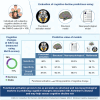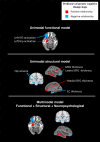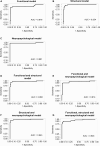Predicting cognitive change using functional, structural, and neuropsychological predictors
- PMID: 40337465
- PMCID: PMC12056721
- DOI: 10.1093/braincomms/fcaf155
Predicting cognitive change using functional, structural, and neuropsychological predictors
Abstract
To effectively address Alzheimer's disease, it is crucial to understand its earliest manifestations, underlying mechanisms and early markers of progression. Recent findings of very early brain activation anomalies highlight their potential for early disease characterization and predicting future cognitive decline. Our objective was to evaluate the value of brain activation-both individually and in combination with structural and neuropsychological measures-for predicting cognitive change. The study included 105 individuals from the Consortium for the Early Identification of Alzheimer's Disease-Quebec cohort who exhibited subjective cognitive decline or mild cognitive impairment. Cognitive decline was assessed by calculating the slope of Montreal Cognitive Assessment scores using regression models across successive assessments, and individuals were characterized as either decliners or stable based on clinically reliable change. We evaluated cognitive decline predictions using unimodal models for each class of predictors and multimodal models that combined these predictors. Functional activation emerged as a strong predictor of cognitive change (R²=52.5%), with 87.6% accuracy and 98.7% specificity, performing comparably to structural and neuropsychological measures. Although the unimodal functional model exhibited high specificity, indicating that functional abnormalities frequently predict future decline, it had low sensitivity (60%), meaning that the absence of abnormalities does not rule out future decline. Multimodal models provided greater explanatory power than unimodal models and greater sensitivity than the functional model. These findings highlight the potential role of early brain activation anomalies in the early detection of future cognitive changes, offering valuable insights for clinicians and researchers in assessing cognitive decline risk and refining clinical trial criteria.
Keywords: brain structure; functional magnetic resonance imaging; mild cognitive impairment; neuropsychological measures; subjective cognitive decline.
© The Author(s) 2025. Published by Oxford University Press on behalf of the Guarantors of Brain.
Conflict of interest statement
The authors declare no conflicts of interest.
Figures



Similar articles
-
Multimodal brain age estimates relate to Alzheimer disease biomarkers and cognition in early stages: a cross-sectional observational study.Elife. 2023 Jan 6;12:e81869. doi: 10.7554/eLife.81869. Elife. 2023. PMID: 36607335 Free PMC article.
-
Prediction of Cognitive Decline for Enrichment of Alzheimer's Disease Clinical Trials.J Prev Alzheimers Dis. 2022;9(3):400-409. doi: 10.14283/jpad.2022.49. J Prev Alzheimers Dis. 2022. PMID: 35841241
-
Automatic Prediction of Cognitive and Functional Decline Can Significantly Decrease the Number of Subjects Required for Clinical Trials in Early Alzheimer's Disease.J Alzheimers Dis. 2021;84(3):1071-1078. doi: 10.3233/JAD-210664. J Alzheimers Dis. 2021. PMID: 34602478 Free PMC article.
-
Structural magnetic resonance imaging for the early diagnosis of dementia due to Alzheimer's disease in people with mild cognitive impairment.Cochrane Database Syst Rev. 2020 Mar 2;3(3):CD009628. doi: 10.1002/14651858.CD009628.pub2. Cochrane Database Syst Rev. 2020. PMID: 32119112 Free PMC article.
-
Evolving Evidence for the Value of Neuroimaging Methods and Biological Markers in Subjects Categorized with Subjective Cognitive Decline.J Alzheimers Dis. 2015 Sep 24;48 Suppl 1:S171-91. doi: 10.3233/JAD-150202. J Alzheimers Dis. 2015. PMID: 26402088 Review.
References
-
- Villemagne VL, Burnham S, Bourgeat P, et al. Amyloid β deposition, neurodegeneration, and cognitive decline in sporadic Alzheimer’s disease: A prospective cohort study. Lancet Neurol. 2013;12(4):357–367. - PubMed
-
- Hudon C, Belleville S, Souchay C, Gély-Nargeot MC, Chertkow H, Gauthier S. Memory for gist and detail information in Alzheimer’s disease and mild cognitive impairment. Neuropsychology. 2006;20(5):566–577. - PubMed
-
- Petersen RC, Doody R, Kurz A, et al. Current concepts in mild cognitive impairment. Arch Neurol. 2001;58(12):1985–1992. - PubMed
LinkOut - more resources
Full Text Sources
